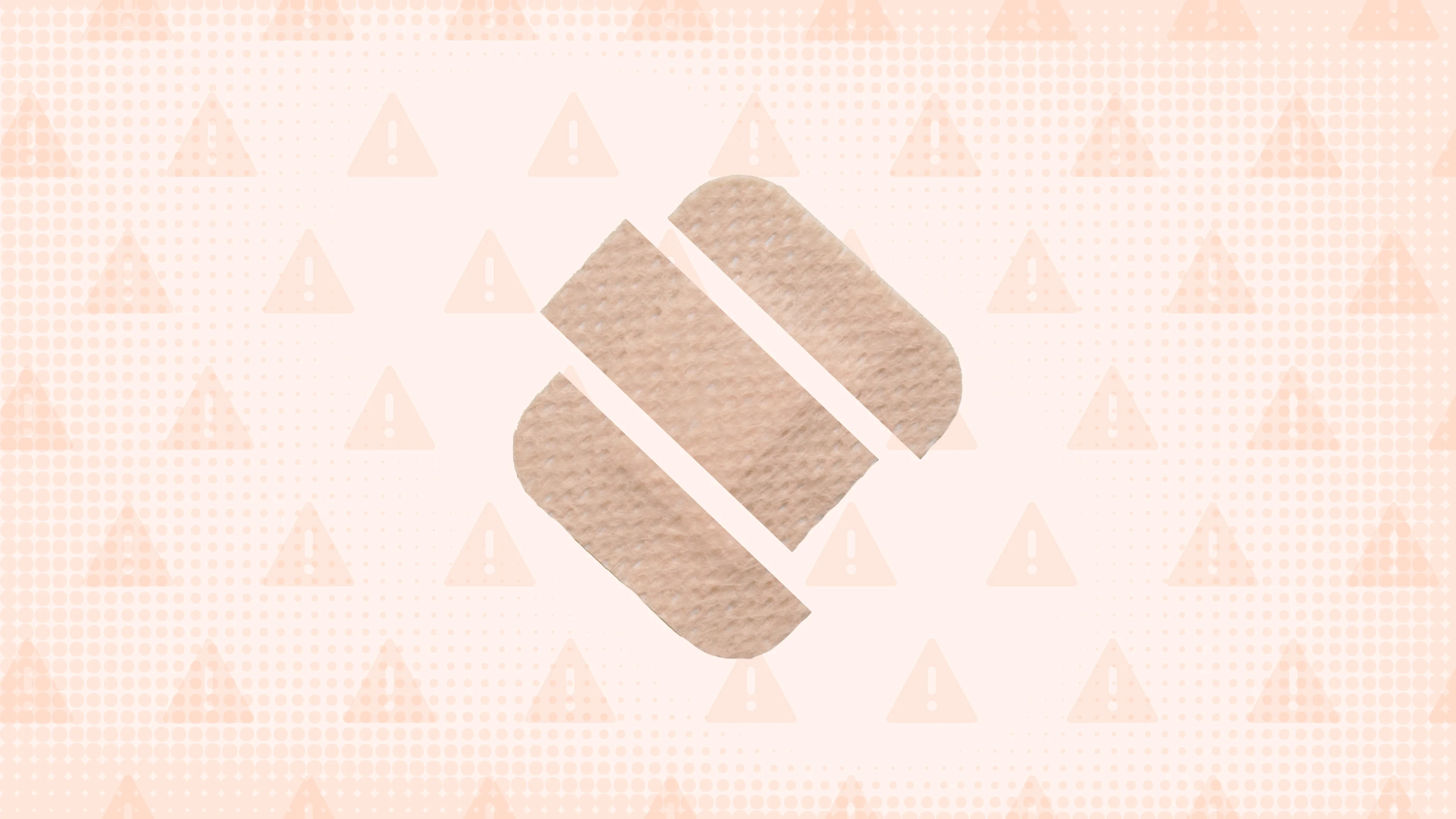Key takeaways:
Estradiol patches (Climara, Vivelle-Dot, and others) are commonly used to help manage menopause symptoms, such as hot flashes.
Common estradiol patch side effects include skin irritation, headaches, and breast tenderness. Bloating and increased vaginal discharge are also possible. These side effects are generally mild and can be managed at home.
Rare but serious estradiol patch side effects include breast and uterine cancer, and cardiovascular problems, such as heart attack or stroke. Discuss these risks with your prescriber before using estradiol patches.
Save on related medications
Estradiol patches (Climara, Vivelle-Dot, and others) are one form of menopausal hormone therapy (MHT). They provide a pill-free way to deliver estrogen to the body. Raising estrogen levels can help reduce menopause symptoms, such as hot flashes and vaginal dryness.
Like any medication, estradiol patches may cause side effects. Here, we’ll discuss what you can expect with estradiol patches so you can manage side effects as they arise.
Good to know: Estradiol patches come in many different brand names and doses. The side effects listed in this article can happen with any estradiol patch.
Estradiol patch side effects at a glance
Estradiol patches are usually well tolerated. Many people experience fewer side effects while using the patches than when taking oral estradiol pills. But you may still experience the side effects listed below.
Search and compare options
Common or mild estradiol patch side effects include:
Skin irritation
Breast tenderness
Headache
Nausea
Stomach pain
Bloating
Gas
Increased vaginal discharge
Joint pain
Mood swings
Runny nose
Back pain
Rare but serious estradiol patch side effects include:
Depression
Vaginal bleeding
Gallbladder problems
Liver damage
Raised blood pressure
Worsening of other health conditions, such as chronic migraine
Vision problems
The labeling for estradiol patches includes several boxed warnings. These are the strictest warnings that the FDA gives a medication. While rare, these side effects can be life-threatening. Estradiol patches have the following boxed warnings:
Higher risk of breast or uterine cancer
Cardiovascular problems, such as heart attack or stroke
Dementia
This isn’t a complete list of all possible estradiol patch side effects. Tell your prescriber if you experience anything unusual or bothersome after starting this medication — even if it isn’t listed here.
Read on to learn more about seven estradiol patch side effects and how to manage them.
1. Skin irritation
Depending on your estradiol patch dosage, you’ll change your patch 1 to 2 times per week. It’s common to experience skin irritation, redness, or itching where you placed the patch. This is typically due to the sticky substance on the patch — not necessarily because of the estradiol in the patch.
Rotating where you place your patch can help prevent irritation. Choose a different location for each new patch, and wait at least 1 week before reusing a particular area.
More than medications: There are many lifestyle strategies you can follow to help with your menopause symptoms. Read about these self-care tips that don’t require medications.
Other estrogen medications: Estradiol patches are just one type of estrogen supplement for menopause. Read this in-depth guide about estrogen supplements, including patches, pills, and more.
Hormones and breast cancer: Experts discuss the link between menopausal hormone therapy (MHT) and breast cancer. Learn more about the research on MHT and its potential risks.
Skin irritation from estradiol patches is usually mild, and should resolve once the patch is removed. Tell your prescriber if the irritation is bothersome or lasts a long time. They may suggest a smaller-sized patch to help reduce irritation.
2. Breast tenderness
Breast tenderness is a common estradiol patch side effect. The higher your dose, the more likely it is that you’ll experience breast tenderness. You may notice this more when first starting the patch. It should resolve once your body adjusts to the medication.
Try these tips to help reduce breast tenderness:
Wear a supportive bra that’s comfortable for you.
Apply warm or cool compresses to your breasts.
Ask your healthcare team about safe, over-the-counter (OTC) pain relievers, such as acetaminophen (Tylenol).
Contact your prescriber right away if you experience severe breast pain or notice a change to your breast size, shape, or appearance. These can be signs of a more serious problem, such as breast cancer.
3. Headache
Headaches are another common estradiol patch side effect. They’re most common shortly after starting the patch. Headaches should resolve once your body adjusts to the medication.
Headaches from estradiol patches are generally mild and can be treated at home. Try these tips for headache relief:
Drink more water.
Rest in a dark room until your headache pain passes.
Limit the amount of alcohol you drink.
Ask your healthcare professional if OTC headache medications are safe for you.
Talk to your prescriber if your headaches are frequent, bothersome, or don’t go away with OTC treatments.
4. Digestive side effects, such as bloating
Estradiol patches can cause several digestive side effects. These include:
Gas
Nausea
Stomach pain
Generally, digestive side effects from estradiol patches are mild. They normally occur when first starting the patch, and should improve with time.
In the meantime, there are things you can do to manage digestive side effects, including:
Avoiding spicy, fried, or high-fiber foods
Eating smaller, more frequent meals
Eating bland foods, such as toast or bananas, for a short period of time
Asking your healthcare team about OTC options for relief, such as simethicone (Gas-X)
If you experience any of these symptoms and they don’t seem to improve, contact your prescriber.
5. Vaginal discharge
Estradiol patches may also cause a change in the amount or consistency of your vaginal discharge. This generally isn’t harmful and is caused by changing estrogen levels.
Tell your prescriber if your discharge has a bad odor or a cottage cheese-like appearance. You should also tell them if you experience new or worsening vaginal itching or irritation. These are potential symptoms of vaginal infections.
Estradiol patches can sometimes cause spotting or irregular vaginal bleeding. If you haven’t yet completed menopause, you may notice changes to your menstrual cycle. Keep in mind these changes also happen naturally during perimenopause (the transition years before menopause).
If you’ve completed menopause, contact your prescriber if you experience vaginal bleeding. Vaginal bleeding after menopause can be a symptom of more serious problems, such as uterine cancer.
6. Cardiovascular risks
All estradiol products, including patches, have a boxed warning for serious cardiovascular problems. These include:
Blood clots
While rare, there are risk factors that can make these serious side effects more likely. These include the type of menopausal hormone therapy (MHT) you use and when you started using it.
Some studies show that estradiol patches have a lower risk of blood clots compared to oral estradiol pills. And those who started using the patch at the beginning of menopause may also have a lower risk.
Despite its heart-related risks, estradiol is considered safe for most people. Discuss these risks with your prescriber before starting estradiol patches.
7. Breast and uterine cancer
A higher risk of breast and uterine cancer is another boxed warning for estradiol products. The higher the dosage and the longer you use them, the higher your risk. The type of MHT you’re using and the age you were when you started MHT may also play a role.
People using estrogen medications without other hormonal medications don’t seem to be at greater risk for breast cancer. But there is a link between breast cancer and using estrogen along with a progesterone medication.
Progesterone, such as medroxyprogesterone (Provera), is a typical part of MHT if you still have your uterus. Estradiol can thicken the lining of your uterus, which can lead to cancer. Taking progesterone helps prevent this from happening.
Estradiol patches (with or without progesterone) are still a safe choice for most people despite these risks. Your prescriber can help you find the lowest estradiol dose to manage your symptoms. They’ll also help you decide how long to use the patch and when you should stop MHT.
If you have a personal or family history of breast or uterine cancer, tell your prescriber. They may recommend that you take another menopause medication.
Good to know: The studies that linked MHT to breast cancer focused on conjugated estrogens (Premarin) and medroxyprogesterone. These studies didn’t include estradiol. Some research suggests that oral estradiol may have a lower risk of serious side effects than oral conjugated estrogens. But to be safe, it’s not usually recommended for people with higher cancer risks to use estradiol patches.
Do estradiol patches cause weight gain?
No, estradiol patches aren’t known to cause weight gain. But menopause itself can cause changes in body weight. And estradiol patches can cause temporary mild fluid retention and bloating. This is most noticeable shortly after starting the patch and should resolve with time.
Talk to your prescriber if you experience weight gain that causes discomfort. They can help you develop a plan to maintain a body weight that’s healthy for you.
The bottom line
Estradiol patches (Climara, Vivelle-Dot, and others) can be helpful for managing menopause symptoms. Common estradiol patch side effects include skin irritation, headaches, and breast tenderness. Bloating and increased vaginal discharge may also occur. Rare but serious estradiol patch side effects include breast and uterine cancer, and cardiovascular problems. Discuss these risks with your prescriber before starting estradiol patches.

Why trust our experts?



References
American College of Obstetricians and Gynecologists. (2021). Endometrial hyperplasia.
Breastcancer.org. (2024). Breast pain (mastalgia).
DePolo, J. (2024). Using HRT (hormone replacement therapy).
Ettinger, B. (2005). Vasomotor symptom relief versus unwanted effects: Role of estrogen dosage. The American Journal of Medicine.
Graham, S., et al. (2022). Review of menopausal hormone therapy with estradiol and progesterone versus other estrogens and progestins. Gynecological Endocrinology.
Morris, G., et al. (2023). Hormone replacement therapy in women with history of thrombosis or a thrombophilia. Post Reproductive Health.
Mylan Pharmaceuticals. (2025). Estradiol patch [package insert].

















